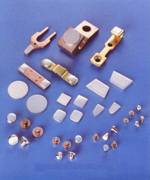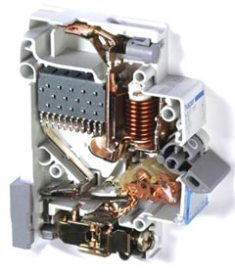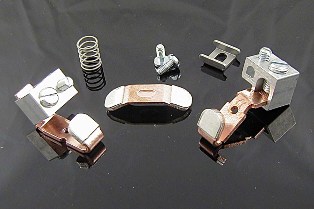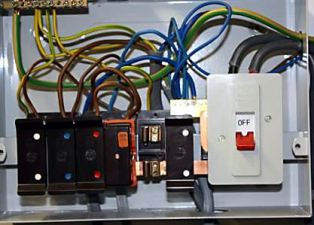Parameters of switching contacts of electrical devices
Solution for contacts of electrical devices
In low-voltage electrical devices, the contact solution is mainly determined by arc extinguishing conditions and only at significant voltages (over 500 V) does its value begin to depend on the voltage between the contacts. Experiments show that the arc leaves the contacts already at a solution of 1 — 2 mm.
The most unfavorable conditions for extinguishing the arc are obtained with direct current, the dynamic forces of the arc are so great that the arc actively moves and extinguishes already at a solution of 2 — 5 mm.
According to these experiments, it can be considered that in the presence of a magnetic field for extinguishing the arc at a voltage of up to 500 V, it is possible to take a solution value of 10 — 12 mm for direct current, for alternating current , 6 — 7 mm are taken for any current values. An excessive increase in the solution is undesirable, as it leads to an increase in the travel of the contact parts of the apparatus and, therefore, to an increase in the dimensions of the apparatus.
The presence of a bridge contact with two breaks makes it possible to reduce the contact travel, while maintaining the overall value of the solution. In this case, a solution of 4 — 5 mm is usually taken for each break. Particularly good arc extinguishing results are obtained with the use of an AC bridge contact. Usually, excessive reduction of the solution (less than 4 — 5 mm) is not done, because errors in the manufacture of individual parts can significantly affect the size of the solution. If it is necessary to obtain small solutions, it is necessary to provide for the possibility of its adjustment, which complicates the design.
If the contacts work in conditions where they can be heavily contaminated, the solution should be increased.
Usually the solution is increased and. for contacts opening the circuit with high inductance, because at the moment of arc extinction, significant overvoltages occur, and with a small gap, re-ignition of the arc is possible. The solution is also increased for the contacts of protective devices to increase their reliability.
The solution increases significantly with increasing AC frequency, since the rate of voltage rise after the arc is extinguished is very high, the gap between the contacts does not have time to deionize and the arc is ignited again.
The magnitude of the high frequency AC solution is usually determined experimentally and is highly dependent on the design of the contacts and the arc chute. At a voltage of 500-1000 V, the size of the solution is usually taken as 16-25 mm. Larger values refer to contacts that switch off circuits with higher inductance and higher currents.
Malfunction of contacts of electrical devices
Contacts wear out during operation. To ensure their reliable contact for a long time, the kinematics of the electrical apparatus is carried out in such a way that the contacts touch before the movable system (moving system of movable contacts) reaches the stop. The contact is attached to the moving system by a spring. Therefore, after contact with the stationary contact, the movable contact stops, and the movable system moves forward until it stops, further compressing the contact spring.
Thus, if the fixed contact is removed in the closed position of the movable system, then the movable contact will be displaced by a certain distance called immersion. Immersion determines the wear limit of a contact for a given number of operations. All other things being equal, greater immersion provides higher wear resistance, i.e. longer service life. But a bigger failure usually requires a more powerful propulsion system.
Contact pressing — the force pressing the contacts at the place of their contact. A distinction is made between the initial pressing at the time of the initial contact of the contacts, when the immersion is zero, and the final pressing with complete failure of the contacts. As the contacts wear, the sinking decreases and, accordingly, the additional compression of the spring. The final press is closer to the original. Therefore, the initial pressure is one of the main parameters in which the contact must remain functional.
 The main function of the fault is to compensate the wear of the contacts, therefore, the magnitude of the failure is primarily determined by the magnitude of the maximum wear of the contacts, which is usually assumed: for copper contacts — for each contact up to half of its thickness (total wear is the total thickness of one contact); for contacts with solders — Until the complete wear of the solder (full wear is the total thickness of the solder of the movable and fixed contacts).
The main function of the fault is to compensate the wear of the contacts, therefore, the magnitude of the failure is primarily determined by the magnitude of the maximum wear of the contacts, which is usually assumed: for copper contacts — for each contact up to half of its thickness (total wear is the total thickness of one contact); for contacts with solders — Until the complete wear of the solder (full wear is the total thickness of the solder of the movable and fixed contacts).
In the case of a contact grinding process, especially in rolling, the amount of plunge is very often much greater than the maximum wear and is determined by the kinematics of the moving contact, which provides the necessary rolling and sliding. In these cases, to reduce the total travel of the movable contact, it is advisable to place the axis of rotation of the movable contact holder as close as possible to the contact surface.
The values of the minimum permissible contact pressure are determined by the conditions for maintaining a stable contact resistance. If special measures are taken to save stable contact resistance, the values of the minimum contact pressures can be reduced. So, in special equipment of small dimensions, the contact material of which does not give an oxide film and the contacts are absolutely reliably protected from dust, dirt, moisture and other external influences, the contact pressure is reduced.
The final contact pressure does not play a decisive role in the operation of the contacts, and its magnitude should theoretically be equal to the initial pressure.However, the choice of failure is almost always related to compressing the contact spring and increasing its force; therefore it is structurally impossible to achieve the same contact pressure — initial and final -. Usually, the final contact pressure for new contacts exceeds the initial one and a half to two times.
Dimensions of contacts of electrical devices
Their thickness and width greatly depend on both the design of the contact connection and the design of the arc device and the design of the entire apparatus as a whole. These sizes in different designs can be very diverse and strongly depend on the purpose of the device.
It should be noted that the size of the contacts, which often break the circuit under current and extinguish the arc, is desirable to increase. Under the action of a frequently interrupted arc, the contacts become very hot; the increase in their size, mainly due to the heat capacity, makes it possible to reduce this heating, which leads to a very noticeable reduction in wear and to the improvement of the conditions for extinguishing the arc. Such an increase in the thermal capacity of the contacts can be carried out not only by directly increasing their dimensions, but also by extinguishing arc horns connected to the contacts in such a way that not only the electrical connection is made, but also a good removing heat from the contacts.
Vibration of electrical device contacts
Contact vibration — the phenomenon of periodic recovery and subsequent closing of contacts under the influence of various causes.Vibrations can be damped when the amplitudes of the rebounds decrease and after a while stop, and not damped when the vibration phenomenon can continue at any time.
Contact vibrations are extremely harmful because the current flows through the contacts and at the moment of bounce an arc occurs between the contacts, causing increased wear and sometimes welding of the contacts.
The cause of the damped vibration that occurs when the contacts are turned on is the impact of the contact against the contact and their subsequent rebound from each other due to the elasticity of the contact material - mechanical vibrations.
It is impossible to completely eliminate mechanical vibrations, but it is always desirable to keep both the amplitude of the first bounce and the total time of vibration as small as possible.
The vibration time is characterized by the ratio of the contact mass to the initial contact pressure. It is desirable to have the smallest value in all cases. It can be reduced by reducing the mass of the movable contact and increasing the initial contact pressure; however, the reduction in mass should not affect the heating of the contacts.
Particularly long switch-on vibration times are obtained if the contact pressure does not rise sharply to its actual value at the moment of contact. This happens when the design and kinematic diagram of the movable contact is incorrect, when after touching the contacts, the initial pressure is established only after the selection of the hinge clearance.
It should be noted that increasing the grinding process, as a rule, increases the vibration time, since the contact surfaces, when moving relative to each other, encounter irregularities and roughness that contribute to the bounce of the moving contact. This means that the pinch size should be chosen at the optimum size, usually determined empirically.
The reason for the constant vibration of the contacts that occurs when they are closed are electrodynamic efforts... Since vibrations under the action of electrodynamic forces occur at high current values, the resulting arc is very intense, and due to such vibration of the contacts, as a rule, they are welded. Thus, this type of contact vibration is completely unacceptable.
To reduce the possibility of vibration under the action of electrodynamic forces, the current leads to the contacts are often made in such a way that the electrodynamic forces acting on the movable contact compensate the electrodynamic forces arising at the contact points.
When a current of such magnitude passes through the contacts that the temperature of the contact points reaches the melting temperature of the contact material, adhesion forces appear between them and the contacts are welded. Such contacts are considered welded when the force that ensures their divergence cannot overcome the adhesion forces of the welded contacts.
The simplest way to prevent contact welding is to use suitable materials and increase the contact pressure accordingly.



